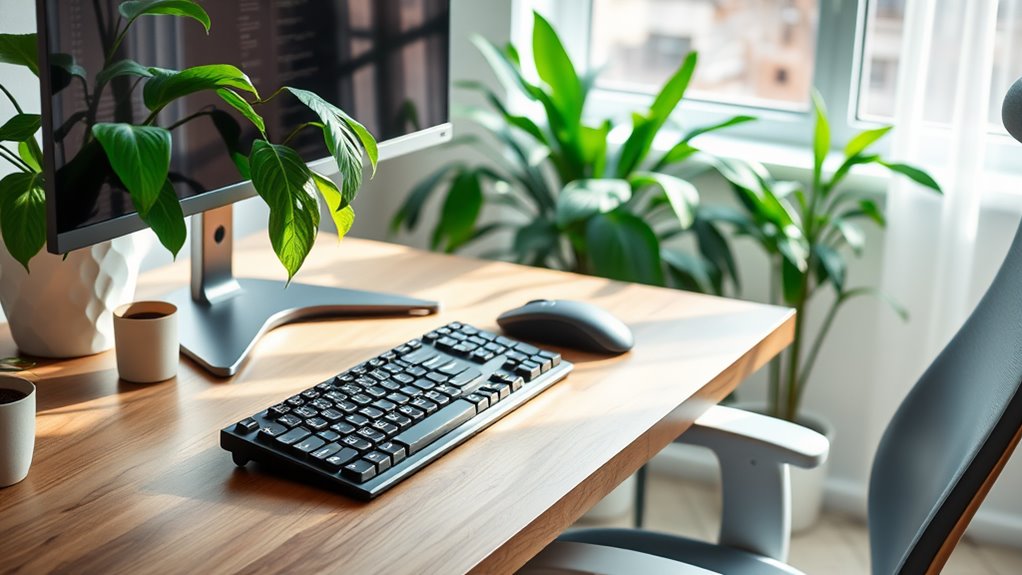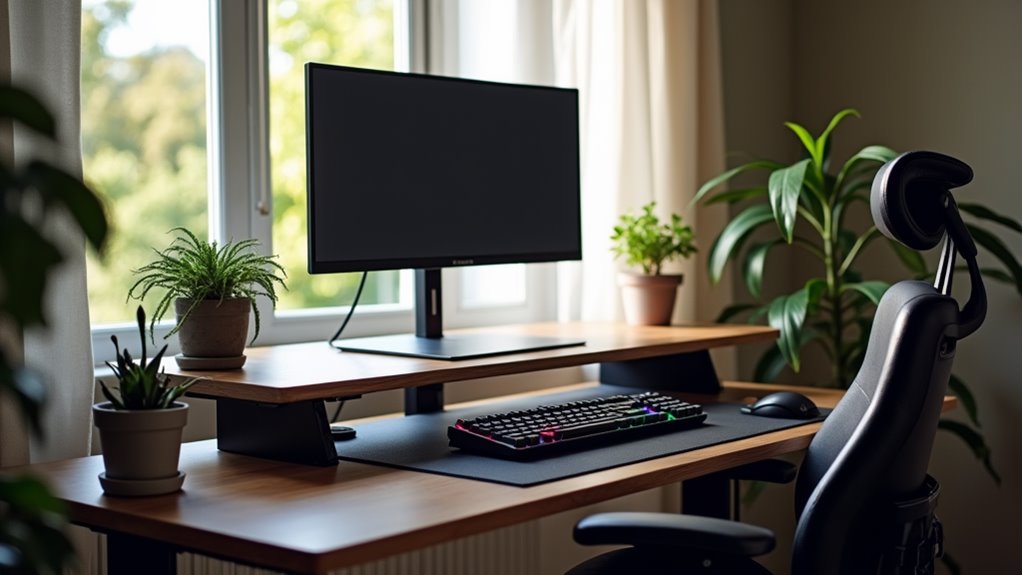Creating an ergonomic coding station is key to your comfort and productivity. Start by choosing a chair with proper lumbar support and adjustable features. Your desk height should allow elbows to rest at 90 degrees while keeping feet flat on the floor. Position your monitor at eye level to avoid neck strain, and keep your keyboard and mouse within arm's reach. Regular breaks and stretching are essential for maintaining overall health. There's so much more to discover for an ideal coding environment!
Key Takeaways
- Choose an adjustable chair with lumbar support to promote good posture and reduce fatigue during long coding sessions.
- Position the monitor at eye level and an arm's length away to minimize neck strain and eye fatigue.
- Keep the keyboard and mouse at elbow height to maintain a natural arm position and reduce wrist strain.
- Take short breaks every hour to improve focus, enhance comfort, and reduce the risk of repetitive strain injuries.
- Personalize your workspace with inspiring colors and decorations to boost creativity and overall productivity.
Choosing the Right Chair for Comfort and Support

Have you ever wondered how much your chair affects your coding experience? The right chair can make all the difference in your comfort and productivity.
The chair you choose can significantly impact your coding comfort and productivity.
When you choose a chair, look for adjustable features like height, armrests, and lumbar support. It should promote good posture, keeping your spine aligned while you code for hours. A chair with adequate cushioning can help reduce fatigue, allowing you to stay focused on your tasks.
Don't forget to take into account the material; breathable fabrics can enhance comfort during long sessions. Test out different styles to find what feels best for you.
Ultimately, investing in a quality chair can lead to a more enjoyable and efficient coding experience, helping you tackle those complex problems with ease.
Finding the Ideal Desk Height
The right desk height is essential for creating a comfortable and productive coding environment. Ideally, when you sit at your desk, your elbows should be at a 90-degree angle, resting comfortably on the surface.
If your desk is too high, you might strain your shoulders; if it's too low, you could experience wrist pain.
To find your ideal height, adjust your chair so your feet rest flat on the floor, and measure the distance from your elbows to the desk.
Consider using a height-adjustable desk if you switch between sitting and standing.
Monitor Placement for Optimal Viewing

To set up your monitor for ideal viewing, make sure it's at eye level to reduce neck strain.
Keep it a comfortable distance from your eyes, typically about an arm's length away.
Don't forget to tilt the screen slightly to minimize glare and enhance visibility.
Eye Level Alignment
When you set up your monitor, ensuring it's at eye level can greatly reduce strain on your neck and eyes.
Position the top of the screen at or slightly below your eye level, allowing for a natural downward gaze. This alignment helps maintain a neutral posture, preventing discomfort during long coding sessions.
You shouldn't have to tilt your head up or down, as this can lead to fatigue over time. If you use a laptop, consider a stand or riser to achieve the correct height.
Additionally, keep the monitor about an arm's length away to promote comfort.
Distance From Eyes
Maintaining an ideal distance from your monitor is essential for reducing eye strain and enhancing focus. You should position your screen about an arm's length away, roughly 20 to 30 inches. This distance helps your eyes relax while you work.
Here's a quick reference table to guide you:
| Distance (inches) | Eye Strain Level | Recommended Action |
|---|---|---|
| 20 | High | Increase distance |
| 25 | Moderate | Adjust as needed |
| 30 | Low | Maintain current setup |
| 35+ | Very Low | Consider larger screen |
Screen Tilt Angle
The angle at which your screen is tilted can greatly impact your comfort and productivity while coding. Ideally, your monitor should be positioned so the top of the screen is at or slightly below your eye level, allowing your eyes to gaze slightly downward. This helps reduce neck strain and keeps your posture aligned.
Here are some tips for ideal screen tilt:
- Tilt the screen back 10 to 20 degrees for better visibility.
- Make sure you can see the entire screen without straining your neck.
- Adjust brightness to minimize glare from overhead lights.
- Position the monitor about an arm's length away.
- Regularly change your viewing angle to reduce eye fatigue.
These adjustments can enhance your coding experience considerably!
Keyboard and Mouse Setup for Ergonomics

To create a comfortable coding environment, you need to focus on the setup of your keyboard and mouse.
Position your keyboard at a height that allows your elbows to stay close to your body, and guarantee your mouse is within easy reach to avoid straining.
Don't forget wrist support techniques to keep your wrists in a neutral position while you work.
Optimal Keyboard Positioning
When you set up your keyboard and mouse, positioning them correctly can greatly reduce strain on your wrists and shoulders.
To achieve ideal keyboard positioning, consider these tips:
- Keep your keyboard at elbow height, allowing your arms to rest comfortably at your sides.
- Position the keyboard about 1-2 inches from the edge of your desk to prevent wrist strain.
- Use a wrist rest if necessary, but make sure it doesn't elevate your wrists too high.
- Tilt the keyboard slightly downward to promote a neutral wrist position.
- Maintain a straight line from your elbows to your wrists, avoiding awkward angles.
Mouse Placement Essentials
While you may focus on keyboard positioning, neglecting mouse placement can lead to discomfort and strain. To optimize your setup, keep your mouse close to your keyboard. This minimizes reaching and helps maintain a natural arm position. Your elbow should rest comfortably at your side, forming a 90-degree angle when using the mouse.
If you're using a traditional mouse, consider its height; it should be level with your keyboard. If you prefer a vertical or ergonomic mouse, make sure it's within easy reach.
Try to keep your wrist straight, avoiding awkward angles during use. Adjust the sensitivity settings to reduce unnecessary movements and enhance control. Prioritizing proper mouse placement will greatly improve your comfort and productivity while coding.
Wrist Support Techniques
Proper wrist support is essential for preventing discomfort and injury during long coding sessions. You can enhance your setup by implementing these techniques:
- Use a wrist rest: Choose one made of gel or foam to cushion your wrists while typing.
- Maintain a neutral position: Keep your wrists straight, avoiding awkward angles that can strain muscles.
- Adjust your chair height: Make sure your elbows are at a 90-degree angle to minimize wrist strain.
- Position your keyboard correctly: Place it at or slightly below elbow height to encourage a relaxed posture.
- Take regular breaks: Stand up and stretch every hour to relieve tension in your wrists.
Incorporating these techniques can greatly improve your comfort and productivity while coding.
Maintaining Proper Posture While Coding
Maintaining good posture is essential for anyone who spends long hours coding, as it can prevent discomfort and long-term health issues.
Start by sitting all the way back in your chair with your feet flat on the floor or on a footrest. Your knees should be at or slightly below hip level. Keep your back straight and shoulders relaxed, avoiding hunching forward.
Position your monitor at eye level, so you don't strain your neck. When typing, keep your wrists straight and hands slightly elevated, using wrist support if necessary.
Take a moment to adjust your chair and desk height to achieve this setup. Practicing good posture while coding not only enhances your comfort but also boosts your productivity.
Importance of Breaks and Stretching
Taking regular breaks and incorporating stretching into your coding routine can greatly enhance your overall well-being. By stepping away from your screen, you refresh your mind and reduce the risk of burnout.
Stretching helps alleviate tension in your muscles, improving circulation and flexibility. Here are some key benefits of taking breaks and stretching:
- Boosts productivity and creativity
- Reduces the risk of repetitive strain injuries
- Enhances focus and concentration
- Improves posture and reduces discomfort
- Promotes overall physical and mental health
Make it a habit to take short breaks every hour and do some quick stretches.
You'll find that a few minutes away from coding can make a significant difference in your performance and comfort.
Additional Accessories for an Ergonomic Workspace
Creating an ergonomic workspace goes beyond just your chair and desk; additional accessories can make a world of difference in your comfort and efficiency.
Consider using a keyboard wrist rest to support your wrists and reduce strain while typing. A mouse pad with wrist support can enhance your grip and minimize discomfort.
Enhance your typing experience with a wrist rest and supportive mouse pad to reduce strain and improve comfort.
An adjustable monitor stand enables you to position your screen at eye level, preventing neck strain. Blue light glasses can help reduce eye fatigue from prolonged screen time.
Finally, a footrest can promote better posture by keeping your feet flat and supporting your lower back.
Investing in these accessories not only enhances your comfort but also boosts your overall productivity during those long coding sessions.
Creating a Personalized Coding Environment
While a comfortable setup is essential, personalizing your coding environment can greatly enhance your focus and creativity.
Tailoring your workspace to reflect your style and preferences makes a significant difference in your productivity. Here are some ideas to get you started:
- Choose your color scheme: Use colors that inspire you, whether calming blues or vibrant reds.
- Add personal touches: Include photos, artwork, or quotes that motivate you.
- Organize your tools: Use unique organizers for your tech gadgets, pens, and notebooks.
- Invest in mood lighting: Adjustable lighting can help reduce eye strain and set the right atmosphere.
- Incorporate plants: Adding greenery can boost your mood and improve air quality.
With these adjustments, you'll create a coding haven that fuels your passion and performance.
Frequently Asked Questions
How Often Should I Adjust My Workspace Setup?
You should adjust your workspace setup regularly, ideally every hour. Stand up, stretch, and refocus. Frequent adjustments help maintain comfort, boost productivity, and reduce strain, ensuring you stay energized and engaged throughout your workday.
Can Lighting Affect My Coding Comfort?
Yes, lighting can greatly affect your coding comfort. Poor lighting may cause eye strain and fatigue, while proper illumination enhances focus and reduces discomfort. Adjust your workspace lighting to create a more productive environment.
What Are the Signs of Poor Ergonomic Setup?
If your back aches, neck hurts, or you experience wrist strain, those are signs of a poor ergonomic setup. You might also notice frequent headaches or fatigue, indicating it's time to reassess your workspace.
Are Standing Desks Better for Ergonomics?
Standing desks can improve ergonomics by promoting better posture and reducing strain. However, alternating between sitting and standing is essential. It's all about finding what works best for you and maintaining comfort throughout your day.
How Does Temperature Impact My Coding Efficiency?
Temperature greatly impacts your coding efficiency. When it's too hot, you might feel sluggish and distracted. Conversely, a comfortable, cool environment keeps you alert, focused, and productive, enhancing your overall coding performance. So, adjust accordingly!
